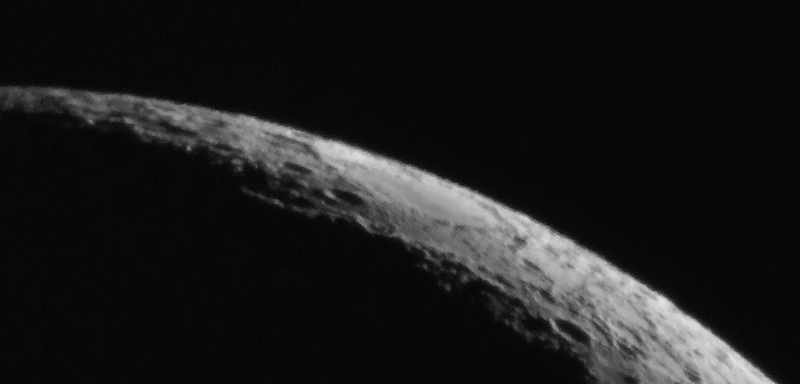
Crescent Moon, Asteroids Ceres and Vesta
Posted: 30 June 2014
|
Opened: Sunday, 29 June 2014, 1928 MST Temperature: 99°F |
Session: 702 Conditions: Clear |
1934 MST: viewed Jupiter, low in the western sky, 83X. Then Mars, 83X and 222X. At 222X, Chryse Planetia was clearly visible.
1939 MST: sunset. 1940 MST: viewed Saturn, 222X. Good view of the Ringed Planet.
1944 MST: returned to Mars for more observing, 222X. The North Polar Cap was visible as well as Chryse Planetia.
1951 MST: slewed to the moon and viewed it using 83X. A very nice view of the crescent. Took this D7000 DSLR photo of the moon low in the western sky at 1955 MST:

Mounted the D7000 DSLR at prime focus of the 8" LX200-ACF and took this photo, 1/500sec, ISO 1600:

Then did some lunar observing, 222X. The view of Mare Humboldtianum at the lunar limb was good. Grabbed this iPhone afocal 222X handheld image (cropped) showing Mare Humboldtianum (although the moon's low altitude blurred it out slightly):

2012 MST: viewed the moon, 83X. Earthshine visible. The moon was now getting into a tree.
Slewed the 8" telescope to Spica and began preparing to view the asteroids Ceres and Vesta. Powered on the GC Wi-Fi Adapter and used SkySafari Pro 4 on the iPhone 5s to GOTO Ceres. The asteroid appeared fairly bright in the 2" 24mm UWA eyepiece (83X). Then had SkySafari GOTO Vesta as I watched the slewing in the eyepiece. Vesta was also fairly bright. I then slewed back towards Ceres. As Ceres came into the field-of-view (FOV), Vesta was also still in the FOV. Nice!
2025 MST: saw and terminated a Kissing Bug on the observatory dome. Guess the season for them is not quite over.
I had originally planned to use a focal reducer to image both asteroids in the same FOV, but seeing them both in the same eyepiece FOV gave me confidence that the focal reducer would not be needed. Mounted the D7000 DSLR at 8" prime focus and did a focus test on the star Spica with the Bahtinov Mask. Used SkySafari to GOTO Ceres and then Vesta while watching the slewing in the camera eyepiece. I was just able to get both asteroids in the same camera FOV. Did a framing test exposure to check. At 2050 MST, I started imaging Ceres and Vesta using 30 second, ISO 1600, exposures every 15 minutes.
This image shows both asteroids. Mouseover or tap to see them labeled.

Mouseover or tap to see labels
Using the five exposures made every 15 minutes from 2050 MST to 2150 MST, I created this merged image showing the motion of both asteroids over the one hour period:

Click or tap on the image to view an animated GIF showing the motion of both asteroids.
The asteroids will be getting closer together over the next several nights, reaching a very close conjunction of 10' on Saturday, 5 July 2014. I hope to image them every night this week, although monsoon storms are now in the forecast beginning on Thursday.
As I mentioned on my previous report, there was a M5.2 earthquake in eastern Arizona 28 June at 2159 MST. The quake was felt here in Oracle. There was no damage in the house or observatory, but I did wonder whether the 8" LX200-ACF polar alignment had been affected. However, all GOTOs were accurate this night, so apparently the tripod had not moved. I will know for certain the next time I do some DSO long duration imaging.
|
Closed: Sunday, 29 June 2014, 2204 MST Temperature: 81°F |
|
Comments are welcome using Email. If you are on Twitter you can use the button below to tweet this report to your followers. Thanks.
Cassiopeia Observatory Home Page